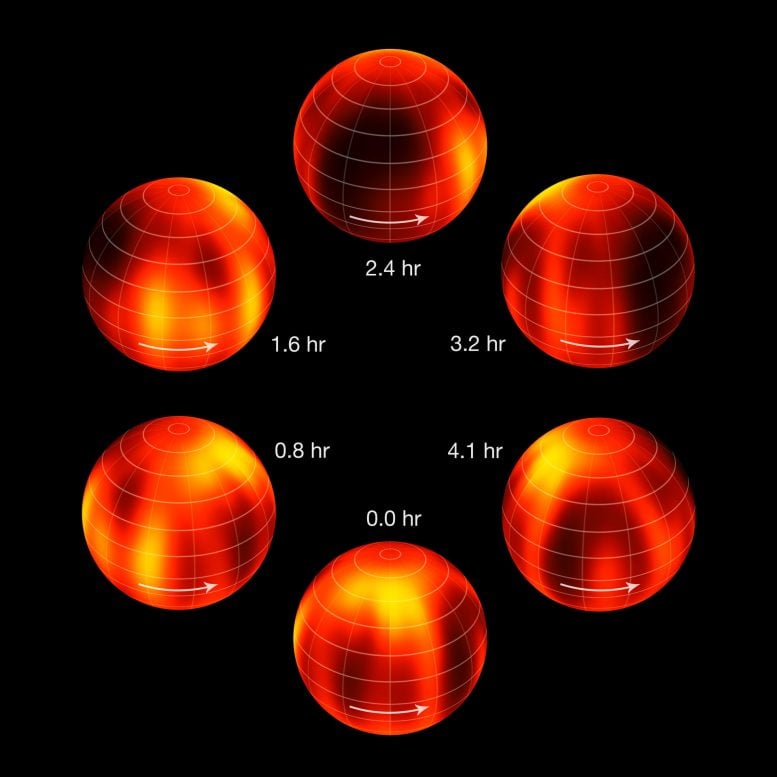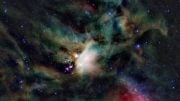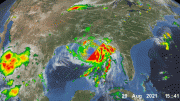
ESO’s Very Large Telescope has been used to create the first ever map of the weather on the surface of the nearest brown dwarf to Earth. An international team has made a chart of the dark and light features on WISE J104915.57-531906.1B, which is informally known as Luhman 16B and is one of two recently discovered brown dwarfs forming a pair only six light-years from the Sun. The figure shows the object at six equally spaced times as it rotates once on its axis. Credit: ESO/I. Crossfield
ESO’s Very Large Telescope has charted the first ever map of the weather on the surface of a Brown Dwarf.
An international team has made a chart of the dark and light features on WISE J104915.57-531906.1B, which is informally known as Luhman 16B and is one of two recently discovered brown dwarfs forming a pair only six light-years from the Sun. The new results are published in the 30 January 2014 issue of the journal Nature.
Brown dwarfs fill the gap between giant gas planets, such as Jupiter and Saturn, and faint cool stars. They do not contain enough mass to initiate nuclear fusion in their cores and can only glow feebly at infrared wavelengths of light. The first confirmed brown dwarf was only found twenty years ago and only a few hundred of these elusive objects are known.
This video shows the first ever map of the weather on the surface of the nearest brown dwarf to Earth. An international team has used ESO’s Very Large Telescope to create a chart of the dark and light features on WISE J104915.57-531906.1B, which is informally known as Luhman 16B and is one of two recently discovered brown dwarfs forming a pair only six light-years from the Sun. This video shows the object as it rotates on its axis. Credit: ESO/I. Crossfield
The closest brown dwarfs to the Solar System form a pair called Luhman 16AB [1] that lies just six light-years from Earth in the southern constellation of Vela (The Sail). This pair is the third closest system to the Earth, after Alpha Centauri and Barnard’s Star, but it was only discovered in early 2013. The fainter component, Luhman 16B, had already been found to be changing slightly in brightness every few hours as it rotated — a clue that it might have marked surface features.
Now astronomers have used the power of ESO’s Very Large Telescope (VLT) not just to image these brown dwarfs, but to map out dark and light features on the surface of Luhman 16B.
Ian Crossfield (Max Planck Institute for Astronomy, Heidelberg, Germany), the lead author of the new paper, sums up the results: “Previous observations suggested that brown dwarfs might have mottled surfaces, but now we can actually map them. Soon, we will be able to watch cloud patterns form, evolve, and dissipate on this brown dwarf — eventually, exometeorologists may be able to predict whether a visitor to Luhman 16B could expect clear or cloudy skies.”
This video sequence is an artist’s impression based on the first ever map of the weather on the surface of the nearest brown dwarf to Earth. An international team used ESO’s Very Large Telescope to make a chart of the dark and light features on WISE J104915.57-531906.1B, which is informally known as Luhman 16B and is one of two recently discovered brown dwarfs forming a pair only six light-years from the Sun. Luhman 16A appears in the background in this sequence. Note that the faint fine detail on the surface of Luhman 16B has been added for artistic effect. Credit: ESO/I. Crossfield/N. Risinge
To map the surface the astronomers used a clever technique. They observed the brown dwarfs using the CRIRES instrument on the VLT. This allowed them not just to see the changing brightness as Luhman 16B rotated, but also to see whether dark and light features were moving away from, or towards the observer. By combining all this information they could recreate a map of the dark and light patches of the surface.
The atmospheres of brown dwarfs are very similar to those of hot gas giant exoplanets, so by studying comparatively easy-to-observe brown dwarfs [2] astronomers can also learn more about the atmospheres of young, giant planets — many of which will be found in the near future with the new SPHERE instrument that will be installed on the VLT in 2014.
Crossfield ends on a personal note: “Our brown dwarf map helps bring us one step closer to the goal of understanding weather patterns in other solar systems. From an early age, I was brought up to appreciate the beauty and utility of maps. It’s exciting that we’re starting to map objects out beyond the Solar System!”
Notes
- This pair was discovered by the American astronomer Kevin Luhman on images from the WISE infrared survey satellite. It is formally known as WISE J104915.57-531906.1, but a shorter form was suggested as being much more convenient. As Luhman had already discovered fifteen double stars the name Luhman 16 was adopted. Following the usual conventions for naming double stars, Luhman 16A is the brighter of the two components, the secondary is named Luhman 16B and the pair is referred to as Luhman 16AB.
- Hot Jupiter exoplanets lie very close to their parent stars, which are much brighter. This makes it almost impossible to observe the faint glow from the planet, which is swamped by starlight. But in the case of brown dwarfs, there is nothing to overwhelm the dim glow from the object itself, so it is much easier to make sensitive measurements.
Reference: “A global cloud map of the nearest known brown dwarf” by I. J. M. Crossfield, B. Biller, J. E. Schlieder, N. R. Deacon, M. Bonnefoy, D. Homeier, F. Allard, E. Buenzli, Th. Henning, W. Brandner, B. Goldman and T. Kopytova, 30 January 2014, Nature.
DOI: 10.1038/nature12955









Be the first to comment on "ESO’s VLT Charts First Map of Weather on the Surface of a Brown Dwarf"